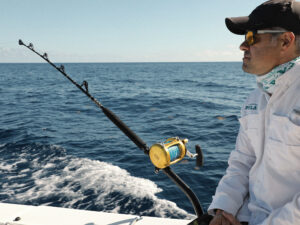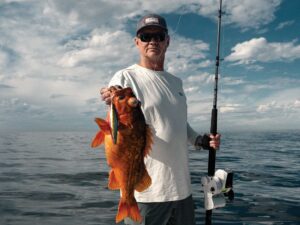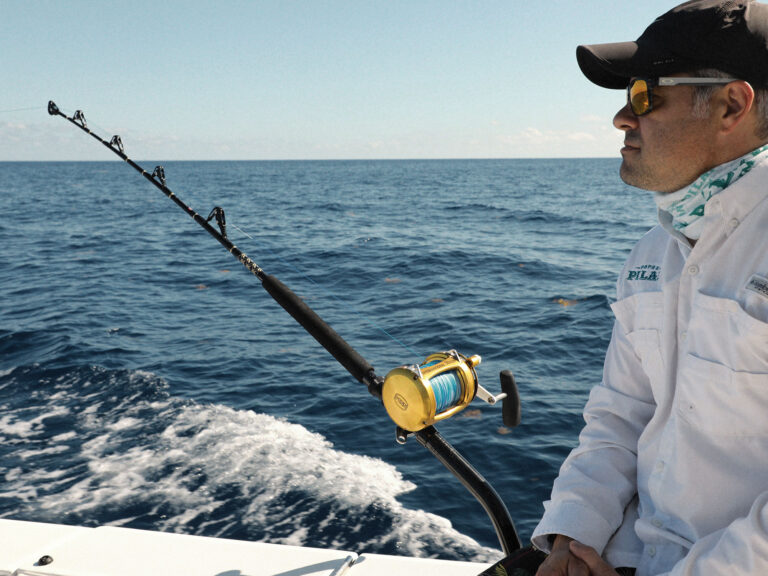
Right here.” My buddy’s words were laden with frustration and confusion. He gestured with his rod in one hand and his empty other hand to the flats surrounding us.
“Right here. I’m telling you that for the last three months we’ve found reds right here, and now, nothing.”
For several hours of a day that was no longer summer and not yet fall, we had worked the same flats that had produced so many redfish the previous few months. Now the single bulls and small schools we were accustomed to seeing patrol the skinny water were noticeably absent.
Clearly, fall was headed our way, and those late-summer reds were already taking up early autumn patterns. We’d need to adjust. I cranked the motor and pointed the bow toward the shore.
“Where we going?” my buddy asked.
“We’re going inside,” I replied.

Cooler Water
Every place where redfish prowl, when autumn temperatures push water temperatures down to the mid- to low 70s, redfish push off the flats where they’d spent warmer days to find deeper, protected water, often adjacent to river and creek mouths, channels, deep cuts and points.
Generally, during the warmer summer months, reds will take to the flats to forage as big loners, in pairs or triples, or in schools of smaller fish. But when they move inside as the water cools, they congregate in more confined areas in anticipation of impending spawning, looking for warmer water in deeper holes.
With more fish in a smaller area, you can anticipate patterns in their behavior. Reds congregate around inshore cuts and ledges, letting the tidal flow bring food to them rather than having to search for it.
Shorelines and ledges of channels and bars work to funnel forage, like shrimp, crabs, mullet and mud minnows, into confined feeding areas that draw redfish.
Fall fish will be more apt to be on the inside of structure, unwilling to venture into shallower, colder water.
Tidal flow through cuts and channels often washes out deeper holes along the contours of ledges and shorelines. These deeper depressions provide reds with warmer waters rather than the cooling waters of the surrounding flats. Thus, locating holes and basins will regularly turn up congregating reds.
Strategically, target your fall redfishing as close to shore as necessary. As water temperatures drop, push inside even farther, tracking reds into the creeks, rivers and channels that push into the backcountry.
Redfish diets change as the water cools. Lower temperatures slow their metabolism. Fish hiding in warmer holes burn more energy than those in colder water, thus they need to eat more than fish in shallower, colder water. So, when looking for reds, locating warm currents and deeper holes increases the likelihood of finding fish and finding those fish with healthy appetites.

Autumn Jitters
When redfish school up as they do in the cooler months, they can also be much more easily spooked than warmwater reds. For whatever reason, larger schools of reds tend to be jittery.
When you locate fall schools, cast around the perimeter of the school. Casts that splash the center of the school or pull lures and baits through the middle of the school tend to spook them.
A hooked red that crashes through a school also spooks the rest before you get a chance for additional hookups. Working the edges of the school increases the odds of leading a hooked fish away from the school.
Read Next: 12 Best Redfish Fishing Spots
Switch Baits
As redfish move inshore, the baits they feed on may also change. Learning which baits move on the fall tides helps you match the lure to the natural forage.
You can also make assumptions about baits relative to the proximity to shore. It is likely that redfish will feed more frequently on mud crabs during the fall because mud crabs reside on oyster bars. Similarly, mud minnows will be more plentiful in fall waters than on the summer flats. Shrimp too congregate along estuarine edges during winter months before spring migrations.
Ultimately, when reds take up occupancy in inshore holes, the best bet is ladyfish chunks, with cut mullet coming in second. While ladyfish are abundant along the flats in the summer, like the redfish, when things cool off, they leave the flats for warmer climes. Finding a ladyfish can be tough in the fall. In anticipation, save a few ladies and chunk and freeze them when they are plentiful. A few dozen cut ladyfish baits from the freezer can really push a fall redfish trip to amazing success.
Because reds will be holed up in deeper water, add a split shot to your baits to get them to the fish.
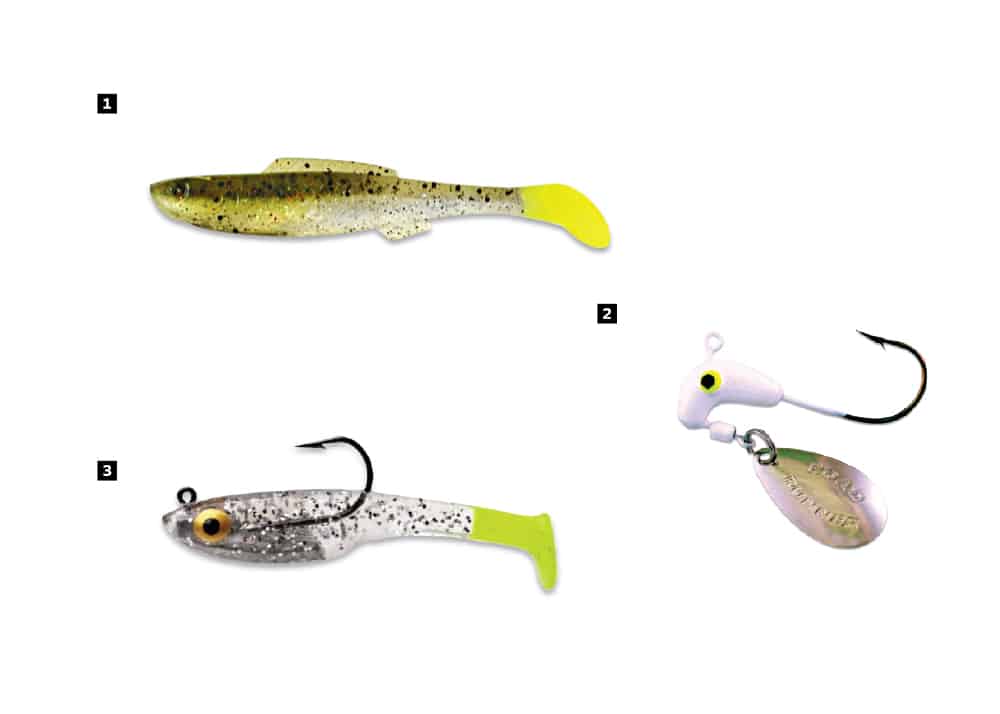
[2] The Blakemore Road Runner, with a spinner on the jig head, adds flash for visibility.
[3] Egret Baits Vudu Vixen is rigged to kick along the bottom without hanging up. Sid Dobrin
Artie Time
Fall reds also hit artificials. Pitching search baits helps you locate reds in holes. Slow-sinking and deeper suspending baits are excellent for locating fish. Lures like Unfair Lures’ Arrowhead, MirrOlure’s MirrOdine, Yo-Zuri’s 3D Inshore Twitchbait, and Bagley’s Rattlin’ B make great fall search baits.
While paddle tails rigged with jig heads are going to be your best bet, rigging with hybrid jig heads, like TTI-Blakemore’s Road Runner heads, adds a spinner blade to the jig head for greater visibility.

[5] In shallow waters, soft plastics such as the Bass Assassin Salty Snack offer a quiet presentation. Sid Dobrin
Darker colors, like root beer, gold, blacks and blues, will be effective in the fall. D.O.A. shad tails offer dozens of color possibilities and great action, as do Unfair Lures’ Smack softbaits and Egret Baits’ Vudu Vixen bodies and Bayou Chubs. I’m also a fan of Bass Assassin’s Salty Snack, rigged with a weighted wide-gap hook.
The benefit of fishing soft bodies is that you can adjust the weight of the jig heads to reach the depths you’ll need for redfish while also having a near-endless array of colors and styles to choose from. Likewise, the soft plastic tends to make less of a splash on the cast, reducing the risk of spooking skittish fish. For anglers devoted to artificials, fall reds demand soft plastics.

[7] Plastic tails, like the Unfair Lures Smack Paddle, should be fitted to a jig head appropriate to the depth. Sid Dobrin
Right Here
I steered the boat into the oyster-bar-encrusted mouth of a small creek and set the anchor as the tide swung around, pushing water into the creek. A few casts later, we had the first of a dozen reds we’d catch over the next hour, including a 27-incher with three spots on the tail and a deep amber-colored back.
“Right here,” my buddy proclaimed, gesturing with his arms at the shoreline around us. “Right here. I’m not leaving right here until it’s too cold to fish.”
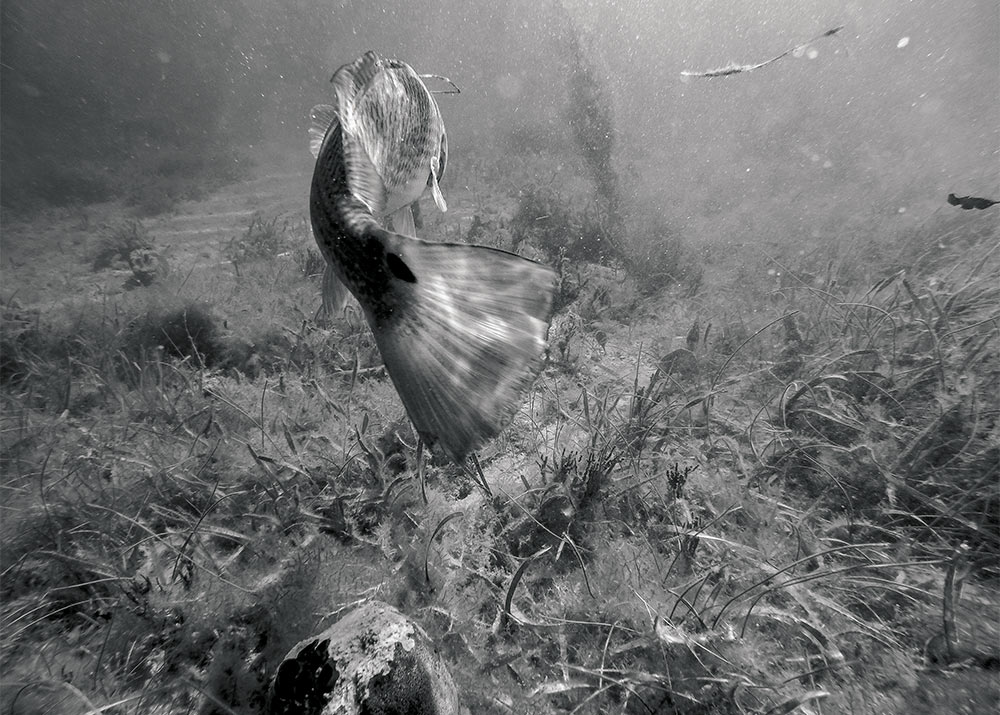
Four Keys for Locating Fall Reds
• Locate areas of strong tidal flow. This requires being alert to tide tables and knowing when water will be moving at its strongest.
• Locate holes. Use depth finders to mark holes along your route. Even a minor depression of 2 or 3 feet in an area of consistent depth provides reds with the warmer temperatures they seek. Reds will look for holes that range from 2 to 10 feet in fall months.
• Work the inside of structure. Even when the tide is flowing out, reds want to stay on the inside of bars, shorelines and rock formations.
• Look for warmer water. Use thermometers and electronics to find warmer holes and currents. Even a degree or two fluctuation affects whether fish are feeding or not.

